Unit 2 What time do you go to school教案
七年级英语下册《Unit 2 What time do you go to school (第2课时)》教案 人教新目标版

课题:Unit2 Reading: Maybe you should learn to relax!Teaching goals:(1)Students can talk about their problems and find out some ways to solve their problems.(2) New words and phrases: football, until, fit, as much as possible, pressure, complain, include, pushy, send, all kinds of, compare, crazy, themselves, adult,on the one hand, on the other hand, orga nized.(3)To be able to write a passage, describe their own feelings about their lives. Preview:1.单词互译:足球到…为止适合,适应包括,包含推动,督促派遣,打发(反身代词)他们自己自由 pressure complain pushy compare crazy adult organized2.not until, fit…into , send…to, by themselves, it’s time for…/to…,as m uchas possible, take part in, see… doing, compare… with, on the one/other hand.通过课件闪现单词,让学生一起快速回答单词含义,达到复习效果,然后进行记忆比赛,看谁能在短时间内将课件闪现的全部单词记住的最多。
(设计意图:由于本篇课文中出现的生词较多,单词的复习和对文章中短语的设计可以让学生更轻松的理解原文,实行抢答可以充分调动学生的积极性。
人教版七年级英语下册《Unit 2 What time do you go to school》教案

《Unit 2 What time do you go to school》教案Teaching objectives knowledgeThetarget1. Learn and master the following words:up get up dress g et dressed brush toothshower take a shower usually forty wownever early fifty job work station radiostation o’clock night funny exercise2. To learn to ask and talk about the spokenlanguage of the time, make the schedule:-What time do you usually take a shower?-I usually take a shower at six forty.-What time do you usually get up?-I usually get up at eight thirty at night.AbilitytoThetarget1) learning with credit to special questions abouttime and time.2) with the knowledge of the target language t o lifeand learning activities to make plans, to reasonablyarrange work and rest time.emotionalTheSection A, talk about the topic is "routine" time,the learning content close to student's life, becausethe students' work and rest time arrangement is verytarget regular. By asking each other or talk about yourself or a loved one's work and rest time arrangementand activity plan, and punctuality can cultivatestudents' good habit, the habit.Teaching important points Learn to ask and talk about time and make the schedule.Teaching difficultpoints Credit to guide the expression of special questionsand time.The teachingmethodTask-based teaching method and teaching.。
七年级英语下册Unit2Whattimedoyougotoschool教案新版人教新目标版
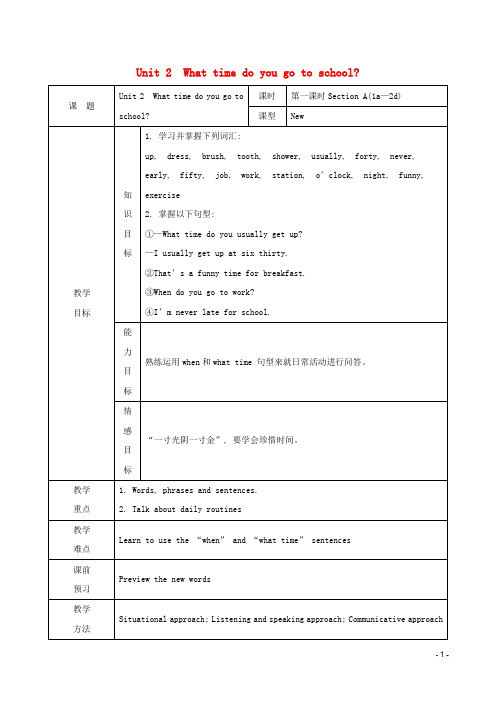
②When does Scott go to work?
③He always goes to work at seven o’clock.
能力目标
1.掌握What time及When特殊疑问句及其答语。
2.熟练使用频度副词
Summarize how to use what time to ask about their daily activities.
培养学生探究、归纳总结能力。
续表
教学环节
教师活动
学生活动
备课札记
Step 8
Consolidation
教师设置巩固检测练习:
Ⅰ.用所给词的适当形式填空
1. What time do you getdressed(dress) every morning?
2. Ss talk about themselves in pairs.
通过利用“信息差”进行口语结对活动,在交流信息过程中,进行真实的交际问答活动。
Step 6
Role-play (2d)
1. Let Ss read the conversation of 2d and answer the questions below.
2. Play the tape of2a.
3. Let Ss look at the chart of 2b carefully.
4. Play the tape of 2b.
1. Ss read the sentences in the box in2abefore listening to the tapபைடு நூலகம்.
Unit2 What time do you go to school 教案1
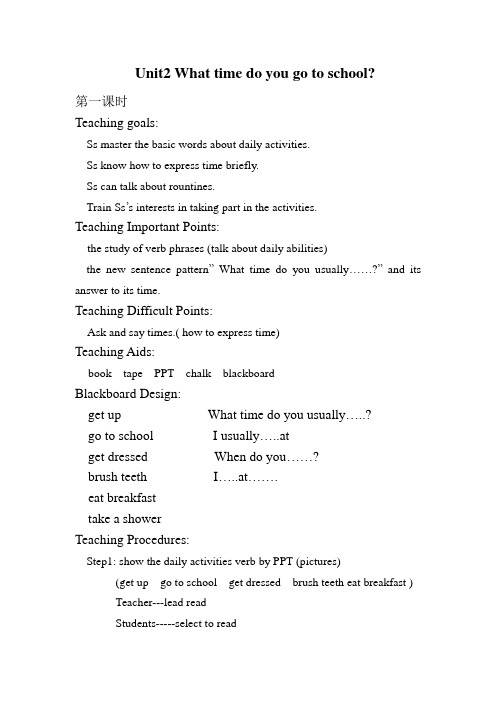
Unit2 What time do you go to school?第一课时Teaching goals:Ss master the basic words about daily activities.Ss know how to express time briefly.Ss can talk about rountines.Train Ss’s interests in taking part in the activities.Teaching Important Points:the study of verb phrases (talk about daily abilities)the new sentence pattern”What time do you usually……?”and its answer to its time.Teaching Difficult Points:Ask and say times.( how to express time)Teaching Aids:book tape PPT chalk blackboardBlackboard Design:get up What time do you usually…..?go to school I usually…..atget dressed When do you……?brush teeth I…..at…….eat breakfasttake a showerTeaching Procedures:Step1: show the daily activities verb by PPT (pictures)(get up go to school get dressed brush teeth eat breakfast )Teacher---lead readStudents-----select to readStep2: check the wordsFinish 1a in the book( Match the activities with the pictures )Pair check class checkStep3: 1. Finish 1b, listen and match the times with the actions. Draw lines from the clocks to the picture.2. lead the sentence by these pictures“ What time do you usually take a shower/?I usually take a shower at six forty.3. practice it with deskmateAsk 3 groups to check.Step4: let Ss learn how to express time3 situations then exercisesStep5: 1.a summary by PPTAsk some students to conclude what they learnt in this class.2. Do a survey( homework )Reflection:第二课时Teaching goals:Ss master the usage of frequency wordsSs can put the frequency words to use.Train Ss’ listening ability.Teaching Important Points:Do 2a and 2b in the book to select important information.the usage of frequency wordsTeaching Difficult Points:Let Ss use the frequency words to make some sentences of their own.. Teaching Aids:book tape PPT chalk blackboardBlackboard Design:Frequency words: always usually often seldom never Teaching Procedures:Step1: review what we have learnt last class1.check the daily activities phrases (write it on the paper)2.practice the sentence” What time do you usually….?”Step2: Do the Listening1.2a: Listen to the conversation and complete the sentences.2.Listen again. Complete the shower schedule for Jim’sfamily. (group check)3.Listen and repeat after the tape.Boys: A Girls: B then exchange to read4.Now talk about yourself. (group work)A: What time do you usually get up?B: I usually get up at six thirty.C: I never get up so early.Step3: How many frequency words have you heard?Lead always often usually sometimes seldom neverUse figure to show its exact meanings by PPTThen do exercisesStep4: HomeworkWrite about something you always do, something you usually do,and something you never do.Reflection:第三课时Teaching goals:Ss master the words about morning, afternoon and evening.Ss know the difference between am and pmTrain Ss have a reasonable plan for their day.Teaching Important Points:the difference between am and pmTeaching Difficult Points:Do the listening (1b and 1c)Teaching Aids:book tape PPT chalk blackboardBlackboard Design:Morning afternoon eveningTeaching Procedures:Step1: 1.a guessing game (human being)2.review how to express time and the frequency words.Step2: 1.How can you show the difference between two o’clock in the morning and two o’clock in the afternoonLead in a.m. and p.m. related to three periods in a day2 Do 1a in P10. Match the activities with the time of a day. Step3: Do the listening1.Listen and circle the activities you hear.2.Listen again. Write the times next to the activities youcircled in 1c.3.Listen and repeat.(boys and girls)4.ask and answer questions about Tom.When does Tom usually get up///?He usually gets up at half past five///.Reflection:第四课时Teaching goals:Ss can express what their daily rountine.Ss should master the language points given by PPTTrain Ss to develop a healthy life style.Teaching Important points:Ss can read the Tony and Mary’s daily life in 2b.SS can understand the language points in 2bTeaching Diffficult Points:Let Ss number the sentences to make a story.Ss can write down their own daily rountine.Teaching Aids:book tape PPT chalk blackboardBlackboard Design:What time / when …e.g. When do you go to school?What time do you go to school?listen to hear look at see look for findTeaching Procedures:Step1: Finish 2a: Check the activities you think are healthy..Step2: Look at a series of pictures of Tony’s daily life by PPT.Let ss have a brief understanding of the passage.Step3: 1. Finish 2b( circle the healthy activities.)2.Write down the unhealthy habits of each person. Then thinkof healthy activities for them.3.Learn important language points:get…make/eat/haveget home lunchget to school dinnerget to work supperget upget readyStep4: Exercise3a. Number the sentences in order to make a storyStep5: WritingWrite about your own daily rountine based on the passage.Step6: Homework:Finish self check after class. Reflection:。
七年级新目标下Unit_2_What_time_do_you_go_to_school教案
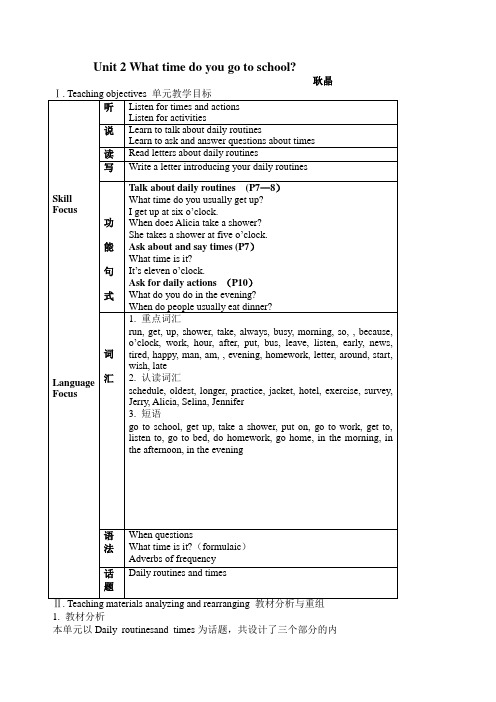
Unit 2 What time do you go to school?耿晶1. 教材分析本单元以Daily routinesand times为话题,共设计了三个部分的内容。
旨在通过单元教学使学生学会谈论日常行为、询问并答复有关时间的问题、询问并回答人们在特定时间所从事的活动。
Section A 学习谈论日常作息时间。
1a, 1b, 1c 重点学习和学生息息相关的几种日常行为的英文表示方法,学会询问和答复日常作息时间。
2a, 2b, 2c ,2d继续学习谈论自己或他人的日常作息时间。
重点学习如何询问,这也是本单元的语法重点。
3a, 3b, 3c 学会叙述他人的日常活动安排,同时学习询问时间和时间表达法,进一步巩固询问别人的日常作息时间的表达法。
Section B 继续学习询问和谈论别人的日常行为。
1a, 1b, 2a, 1c,1d,1e,学会谈论和询问一天内各个时间段的活动安排。
2a,2b,3a,3b学会通过两个人的对比介绍来判断并养成好的作息时间。
Self check 重点单词句型复习2. 课型设计与课时分配Period 1 Listening and speaking (I)(Section A: 1a, 1b, 1c)Period 2 Listening and speaking (II)(Section A:2a, 2b, 2c,2d)Period 3 Integrating skills(Section A:3a, 3b, 3cSection B: 1a, 1b,1c,1d,1e)Period 4 Reading and writing(Section B:2a, 2b, 2c,3a,3b)Period 5 Self checkⅢ. Teaching plans for each periodPeriod 1 Listening and speaking(Ⅰ) Target language目标语言1. Words && phrases生词和短语Up,get up,dress,get dressed,brush,tooth,shower,take a shower,usually,forty, what time,2. Key sentences重点句子When do people usually ...? People usually ...What time do you usually ...? I usually ...Ability goals能力目标Enable students to learn to talk about daily routines.Learning ability goals学能目标Help the students learn how to talk about daily routines.Teaching important / difficult points教学重难点How to talk about daily routines.Teaching aids教具准备A tape recorder and a model clock.Teaching procedures and ways教学过程与方式Step ⅠWarming upIn this procedure, motivate students to learn some words and phrases by singing the songs they’ve learned before.T: Good morning, everyone. (sing) “Good morning to you. Good morning to you. Good morning, dear children. Good morning to you.” This song is easy to learn. Who can sing it to us?Encourage students to sing the song.T: Well done. Thank you! We sing “Good morning to you” in the morning. Then what do we sing in the afternoon and in the evening? S: We sing Good afternoon to you in the afternoon and Good evening to you in the evening.T: That’s right. I know all of you are very good at singing. Does anyone want to sing Good afternoon to you or Good evening to you to us?Step ⅡTalking and reading (1a)In this procedure, ask students to finish the required task and learn some key phrases about daily actions.T: As we all know, time is very important and in English there is a famous saying "An hour in the morning is worth two in the evening." So what do you do in the morning?S1: I read English. S2: I do morning exercise.T: And what do you do in the afternoon and in the evening?S1: I play basketball in the afternoon. S2: I watch TV in the evening.T: I’m very glad to hear that. You use your time very well. And there’re many daily things we can do. Now let’s read these phrases in 1a and match these actions and the time of day.Step ⅢPracticeIn this procedure, students will learn how to talk about actions and the time of day.T: I know you’re very clever. Now I want you to tell if my statements are right or wrong. First, I usually eat dinner in the morning. S: Wrong.T: When do I usually eat dinner? S: In the evening.T: Second, she gets up at 19:00 in the morning. S: Wrong.T: What is the correct way of saying the sentence? S: She gets up at 7:00 in the morning.T: How clever you are! Now let’s read the conversation in groups and see which group reads better.Ask students to do pairwork.T: Please ask your partner when people usually do these things: do homework, eat dinner, eat breakfast and go to bed.(Write “When do people usually ...”on the blackboard)Sample dialogue:S1: When do people usually do homework?S2: People usually do homework in the afternoon.Interest the students in going on practicing the conversation using a new way of reading.T: Now let’s try a new way of reading. First I name one student to ask a question, and then ask all of you repeat this question together. After that, I name another student to answer this question, and all of you repeat the answer together.Sample dialogue:S1: When do people usually go to bed?S: When do people usually go to bed?S2: People usually go to bed in the evening.S: People usually go to bed in the evening.Step ⅣTalking about time (1c)In this procedure, students will learn how to ask about and say hour times and learn some key phrases about daily routines.T: Boys and girls, please listen to what I’m saying and guess what it is. 小小骏马不停蹄,日日夜夜不休息,蹄声哒哒似战鼓,提醒人们争朝夕。
Unit 2 英语教案人教版新目标七年级英语下册

Unit 2 what time do you go to school?(Section A)教学目标:能够听懂、会说并正确使用日常生活中的时间表达方式。
能够用英语描述自己或他人的日常作息时间。
教学重点:时间表达方式。
熟练使用句型“What time do you...?”和“I usually... at...”。
教学难点:用英语描述自己或他人的日常作息时间。
区分at、in、on的用法。
教学准备:课件、多媒体设备。
钟表、日常生活用品图片等教具。
教学过程:Step 1: Warm-upShow some pictures of daily activities, such as getting up, having breakfast, going to school, doing homework, watching TV, and going to bed.Ask students to describe what they usually do at each time of day.Step 2: PresentationPresent some common time expressions, such as "in the morning", "in the afternoon", "in the evening", "at night", "at 6 o'clock", "at 7:30", and "on Monday".Explain the different uses of "at", "in", and "on".Step 3: PracticeHave students work in pairs to ask and answer questions about each other's daily routines using the sentence pattern "What time do you...?" and "I usually... at...". For example: "What time do you get up? I usually get up at 6:30."Ask some students to share their partners' routines with the class.Step 4: ProductionHave students work in pairs or small groups to create a schedule of their own daily routines.Ask some students to share their schedules with the class.Step 5: Culture CornerShow students a map of the world with different time zones marked on it.Explain how time zones work and the difference between a single time zone country like China and a multi-time zone country like the United States.Step 6: HomeworkAssign students to write a short paragraph about their own daily routines using the sentence pattern "I usually... at...".Encourage students to use the time expressions and sentence patterns they have learned in class.教学反思:本课重点介绍了日常生活中常用的时间表达方式和句型,通过让学生在实践中运用这些表达方式和句型,巩固了他们的学习成果。
Unit2 What time do you go to school教案
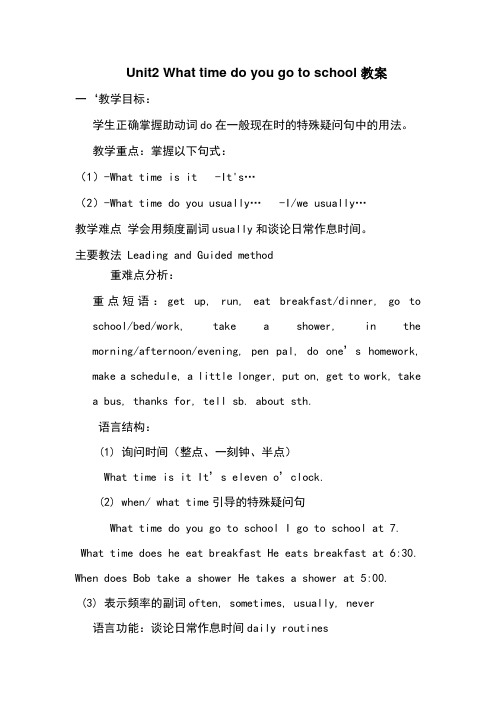
Unit2 What time do you go to school教案一‘教学目标:学生正确掌握助动词do在一般现在时的特殊疑问句中的用法。
教学重点:掌握以下句式:(1)-What time is it -It's…(2)-What time do you usually… -I/we usually…教学难点学会用频度副词usually和谈论日常作息时间。
主要教法 Leading and Guided method重难点分析:重点短语:get up, run, eat breakfast/dinner, go to school/bed/work, take a shower, in the morning/afternoon/evening, pen pal, do one’s homework, make a schedule, a little longer, put on, get to work, takea bus, thanks for, tell sb. about sth.语言结构:(1) 询问时间(整点、一刻钟、半点)What t ime is it It’s eleven o’clock.(2) when/ what time引导的特殊疑问句What time do you go to school I go to school at 7.What time does he eat breakfast He eats breakfast at 6:30. When does Bob take a shower He takes a shower at 5:00.(3) 表示频率的副词often, sometimes, usually, never语言功能:谈论日常作息时间daily routines询问、表达时间ask about and say clock time任务型活动:1. 调查每个同学/家人早上的时间安排2. 小组汇报我的一天,全班评选出安排时间最合理的同学3. 制作节目单/运动会活动安排4.采访名人5.给笔友/朋友写信三、教学手段和方法:Task-based language learning1.Telling time课件或实物练习时间的表达法, 所用句型: What time is it It’s…5 am. = 5 o’clock in the morning 8 pm. = 8 in the evening 5: 15 five fifteen/ a quarter past five / a quarter after five 5: 40 five forty/ twenty to six2.Crossword puzzleAcross(1) It’s five in the morning. It’s five _______.(4) It’s 4:15. It’s a quarter _____ four.(6) It’s twelve . It’s ______(8) It’s 8:00 . It’s eight in the _______(9) It’s twelve . It’s ____________.Down(2) It’s 7:00 a.m. It’s seven in the ________.(3) It’s 3:30. It’s three ________.(4) It’s 4:00 . It’s four in the ________.(5) It’s 1:15. It’s one __________.(7) What ______ is it(10) It’s 11:00 . It’s eleven at ______.3.Survey小组活动, 记录小组成员每天的活动安排。
七年级英语下册Unit-2-What-time-do-you-go-to-school教案
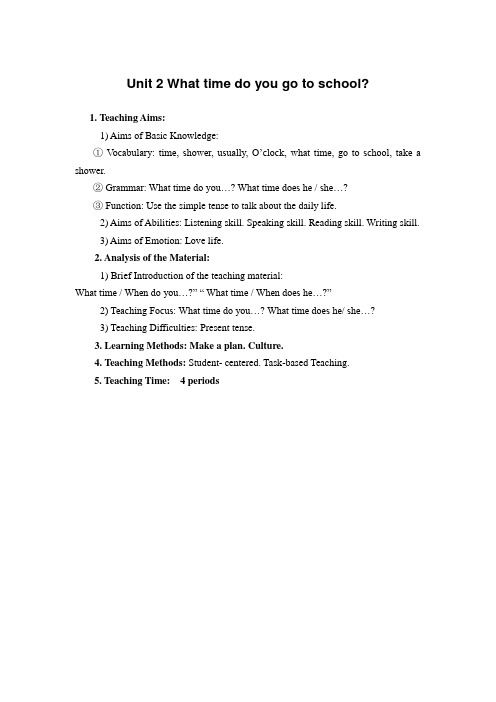
Unit 2 What time do you go to school?1. Teaching Aims:1) Aims of Basic Knowledge:①V ocabulary: time, shower, usually, O‟clock, what time, go to school, take a shower.②Grammar: What time do you…? What time does he / she…?③ Function: Use the simple tense to talk about the daily life.2) Aims of Abilities: Listening skill. Speaking skill. Reading skill. Writing skill.3) Aims of Emotion: Love life.2. Analysis of the Material:1) Brief Introduction of the teaching material:What time / When do you…?” “ What time / When does he…?”2) Teaching Focus: What time do you…? What time does he/ she…?3) Teaching Difficulties: Present tense.3. Learning Methods: Make a plan. Culture.4. Teaching Methods: Student- centered. Task-based Teaching.5. Teaching Time: 4 periodsPeriod 1(Section A: 1a-2a)授课人:______ 授课班级: _____ 授课时间:2014年___月___日____午第____节Step One: Warming-upGreetingT: Good afternoon, everyone.Ss: Good afternoon, Miss Yang.Step Two: Presentation1.Adjust the time, and ask students questions.T: What time is it? Ss: It‟s 12 o‟clock. ( Write on Bb )( Help Ss to say )T: What time is it? Ss: It‟s 10:15.( Help Ss to say )2.Ask one student to come to the front, adjust the time and ask the otherstudents.S1: What time is it? Ss: It‟s 9 o‟clock.3.Teach the new words & phrases.Show some pictures of different clocks and the activities.T: I‟m very busy these days. Can you guess what time I get up / eat breakfast / go to school / run / take a shower? ( Write on Bb)T: I usually get up at 6:35. ( Teach Ss the new word “ usually” )S1: You usually eat breakfast at …S2: You usually run at…S3: You usually take a shower at …4.Ask Ss to do the exercise of 1a, and then check the answers.Step Three: Listening1.Show Ss the timetable of Rick‟s ( write on small Bb )Ask Ss listen to the recorder and fill in the chart.Then check the answers.2.Ask and answer.T: What time does Rick get up / eat breakfast / run / go to school / take a shower ?Ss: He gets up / eats breakfast / runs / goes to school / takes a shower at…( Ask Ss pay attention to the underlined phrases.)Step Four: Consolidation1.Ask Ss to look at the pictures and tell their days.Example: I usually get up at …. I eat breakfast at …. I go to s chool at …. At …, I takea shower.Step Six: Homework1.Try to remember all the words & phrases.2.Survey: Ask your classmates their routines, and give your report.3.Plan: January 1st is coming. Please plan it, and make your day wonderful.Step Seven Blackboard DesignReflection after class:_____________________________________________________________________ _____________________________________________________________________ _____________________________________________________________________ _______________________Period 2 (Section A: 2b-Grammar Focus)授课人:______ 授课班级: _____ 授课时间:2014年___月___日____午第____节1. Aims and demands :1) Language skills :Ss learn to talk about kinds of transportation, and how long it takes to go places, and how far apart places are.2) Target Language : Words : how far , get to , bicycle , subway , bus stop, train station , minute, kilometer, mile , transportation , calendarSentences: How do you get to school ? / How long does it take ? / How far is it ? 3) Moral object : Through learning this unit , Ss can enable them to care for each other whenever crossing the roads and pay attention to the sign of traffic.2. Analysis of the material:Students have learned the transportation before.. In this unit ,they need to learn more details about the transportation. At the same time ,they need to learn “How long and How far” and they can use them freely.3. Teaching methods:pairwork , groupwork ,listening and speaking, practicing4, learning strategies:Personalizing Inferring vocabulary5.Teaching aids:Tape recorder, a projector or a computer6.Teaching period:Four periods.Period 3 (Section B: 3a-3c)授课人:______ 授课班级: _____ 授课时间:2014年___月___日____午第____节1. Aims and Demands: Key vocabulary, How do you get to school ? How does he getto school ?2. Teaching methods : Listening Writing Pairwork3. Teaching Aids : A tape recorder.Step I Leading inT: Good morning, everyone! You know I live far away ,so I go to school by bus every day. What about you? David, “How often do you go to school?”S:--------T: So we will talk about how to get to places in this unit.Step IINow I will show you pic tures and let‟s review the transportations we know. Then we will learn more about it .(take the subway) Please open your books and finish 1a. Step III1. There are five names in 1b.Now they are in the picture. We should find them.2. Play the tape .They should listen carefully and find the persons .Write the numbers next to the correct students in the picture above. After listening , check the answers together .Step IVPoint to the example in the box , ask two students to read it .then ask them to make up their conversations about how the people in the picture get to school .Teacher choose some pairs to act their conversations.Step VPracticing the listening :T: I will play two conversations The people are talking about how students get to school and how long it takes .The first time check the kinds of transportation that you hear. The second time match the time with the kinds of transportation activity 2a.Step VI1. Pay attention to the picture and dialogue.2. Make your own dialogue into pairs.3. Act it in front of the students.Step VIISummary and homework: This class we have learnt some key vocabulary and the target language .I hope after class you can survey how does your friends get to school .and pre-revise the 3a,3b.Step VIII Blackboard DesignReflection after class:_____________________________________________________________________ _____________________________________________________________________ _____________________________________________________________________ __________________________________Period 4授课人:______ 授课班级: _____ 授课时间:2014年___月___日____午第____节。
人教版七年级下学期英语学案设计:unit 2 What time do you go to scho
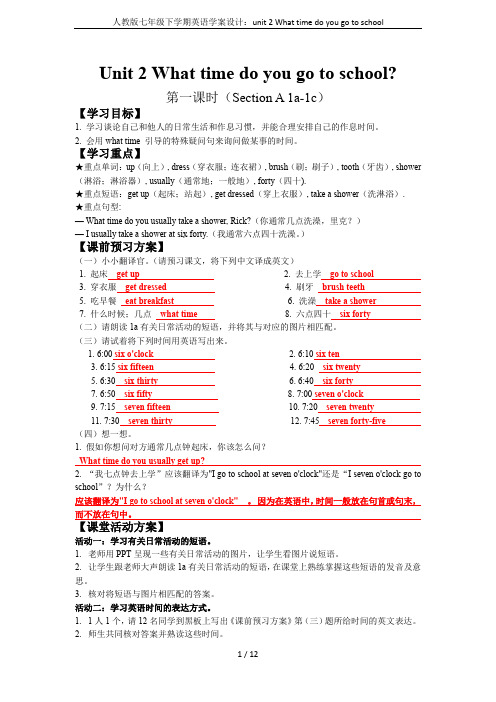
Unit 2 What time do you go to school?第一课时(Section A 1a-1c)【学习目标】1. 学习谈论自己和他人的日常生活和作息习惯,并能合理安排自己的作息时间。
2. 会用what time 引导的特殊疑问句来询问做某事的时间。
【学习重点】★重点单词:up(向上), dress(穿衣服;连衣裙), brush(刷;刷子), tooth(牙齿), shower (淋浴;淋浴器), usually(通常地;一般地), forty(四十).★重点短语:get up(起床;站起), get dressed(穿上衣服), take a shower(洗淋浴).★重点句型:— What time do you usually take a shower, Rick?(你通常几点洗澡,里克?)— I usually take a shower at six forty.(我通常六点四十洗澡。
)【课前预习方案】(一)小小翻译官。
(请预习课文,将下列中文译成英文)1. 起床get up2. 去上学go to school3. 穿衣服get dressed4. 刷牙brush teeth5. 吃早餐eat breakfast6. 洗澡take a shower7. 什么时候;几点what time 8. 六点四十six forty(二)请朗读1a有关日常活动的短语,并将其与对应的图片相匹配。
(三)请试着将下列时间用英语写出来。
1. 6:00 six o'clock2. 6:10six ten3. 6:15 six fifteen4. 6:20 six twenty5. 6:30six thirty6. 6:40six forty7. 6:50six fifty 8. 7:00seven o'clock9. 7:15seven fifteen 10. 7:20seven twenty11. 7:30seven thirty 12. 7:45seven forty-five(四)想一想。
人教版新目标版七年级英语下册 Unit 2 What time do you go to school教案
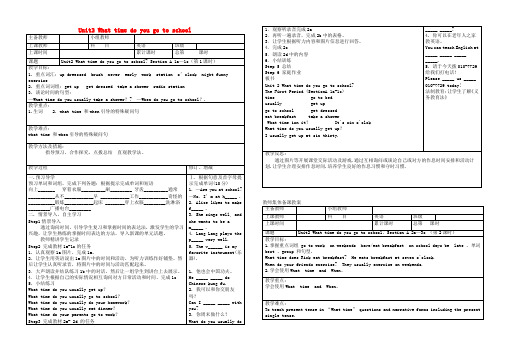
7. 3a: Use“always”,”usually”, or“never”to make sentences.
8. 3b :Let students write about something they do.
Step3 3c :1.make an interview 2. write a short passage
What time do you usually eat dinner?
What time do your parents go to work?
Step3 完成教材2a- 2d 的任务
1.观察听录音完成2a
2.再听一遍录音,完成2b中的表格。
3.让学生根据听力内容和图片信息进行回答。
4.完成2c
5.朗读2d中的内容
2. 重点词词组:get up get dressed take a shower radio station
3. 谈论时间的句型:
—Whattimedo youusuallytake a shower?? —When do you go to school?.
教学重点:
1.生词 2. what time 和when引导的特殊疑问句
1. 他也会中国功夫。
He__________do Chinese kung fu.
2. 我可以和你交朋友吗?
Can I__________with you?
3. 你周末做什么?
What do you usually do__________?
4. 你可以在老年人之家教英语。
You can teach English at____________________.
(完整版)unit 2 what time do you go to school 全单元教案

Unit 2 Period 1 (1a-2c)Teaching aims:1. Can use the words:up, get up, dress, get dressed, brush, tooth (pl。
teeth) brush teeth,shower, take a shower, usually, forty, fifty, wow, never, early.2. Ask about and say times.—What time do you usually get up? —I usually get up at six thirty。
Teaching key points and difficulty:1。
Ask about and say times.2。
Talk about daily routinesAbility aims:1. Improve students’ listening and speaking skills.2. Improve students’ communication competence。
Moral aims“Time is money and time is life。
” Everyone should make full use of time。
教材分析:复习巩固 Numbers 1–301a 呈现动词短语,图片直接呈现,1b 练习时刻的表达,ask and answer,句型比较简单。
1c 巩固练习。
Step 1 .Warm—up and revision。
1. Daily greetings to the Ss。
2。
Revision:the numbers(1—60)Step 2 Ask about the times。
1。
Show the clocks and ask them: -What’s this in English?-What time is it?2. talk about and say timesTeach the students to say times。
人教版七年级英语上册教案Unit 2 What time do you go to school1第一课时
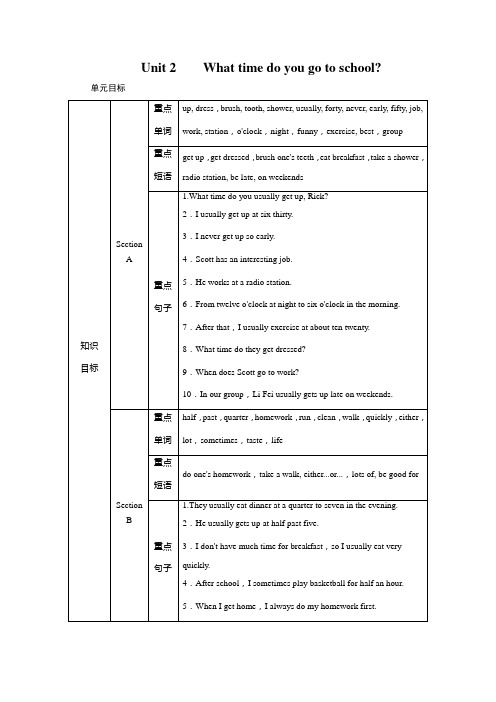
Unit 2What time do you go to school?单元目标第一课时Section A (1a-2d) 课时目标根据句意及音标提示写出单词及其汉语意思。
1.She dresses /dresɪz/ the children in the morning.穿衣服2.You should give your teeth a good brush /brʌʃ/.刷3.We usually /'juːʒʊəlɪ/ go to school by bus. 通常地4.You never /'nevə(r)/ help me.从不5.I get up in the early /'ːlɪ/ morning. 早的6.It's not funny /'fʌnɪ/! 好笑的;滑稽的教学过程环节1新课导入教师向学生展示两张与日常生活相关的图片,然后提出下列问题,学生思考并作出回答。
T:What do you do in the morning?Ss:I brush my teeth.T:What do you do after you brush your teeth?S1:I have my breakfast. My mother makes it for me.S2:I take a bus to school. I have my breakfast on the bus....设计意图:通过直观展示图片吸引学生的眼球,启发他们回忆自己早上会做些什么;通过师生互动的方式,达到活跃课堂氛围的效果。
环节2学习1a-1c1.教师让学生先仔细观察1a中的图片内容,然后理解图片左边的短语含义,然后把短语和图片搭配起来。
最后全班核对答案。
2.教师让学生观察钟表上的时间,并把每个时间标记好,为听力做准备。
3.教师播放1b的录音,学生根据所听内容,将1b上方的图片和对应的时间匹配起来。
Unit 2 What time do you go to school?口语课教学设计

Unit 2 What time do you go to school?口语课教学设计李璐【期刊名称】《英语教师》【年(卷),期】2018(018)012【总页数】4页(P68-71)【作者】李璐【作者单位】130033,吉林长春,吉林大学附中力旺实验中学英语组【正文语种】中文一、课例背景本堂课为一堂学校青年教师汇报展示课,授课对象为小学六年级学生,课型为口语课,时长45分钟,得到了在场教师及专家的一致好评。
二、教学内容本堂课的授课内容为Go For It!七年级(下)Unit 2 What time do you go to school?本单元的主题是用英语描述日常生活,并围绕这一话题展开关于时间、日常行为的讨论。
本堂课是本单元的第一课时,完成好第一课时能够为整个单元奠定很好的语言基础。
本堂课的特殊之处在于授课对象为小学六年级学生,由于小学课本只涉及了数字的表达,并未讲解关于时间的描述,因此讲解时不能像给已经学习过时间的英文表达的初中学生授课一样,对时间的表达一带而过,而是要对时间的表达进行详细的讲解。
因此,课程的第一部分主要用于讲解时间的英文描述。
另外,本单元主要涉及日常活动的动词短语,在讲解完时间后,主要介绍描述日常活动的动词短语。
在讲解完有关时间表达和日常活动的短语后,层层递进,由短语扩展到句型,用时间和动词短语组成句子,训练学生的口语表达能力。
为了更好地体现吉大附中力旺实验中学日常活动的特色,笔者对有关日常活动的短语进行了拓展,增加了学校特有的日常活动,如“morning dance”(晨之舞)等,并录制了学生日常活动的小视频,以激发其学习兴趣。
为了更好地帮助学生掌握教学内容,提高其语言输出能力,在课程的最后笔者还设置了一个“Night Zoo”(夜间动物园)的场景,安排了许多作息时间不同的人物及动物,如 owl,teacher,DJ等,让学生用画笔和胶水先完成某个特定人物或动物的作息海报,再根据海报进行作息时间的汇报,使其在语境中学会并运用目标语言。
七年级英语下册《Unit 2 What time do you go to school Section B (1a—1e)》教案 人教新目标版

课题:Unit 2 What time do you go to school?第三课时 Section B (1a—1e)Learning Goals:In this period, the students will learn the ways to say times. They’ll know there are two ways to say each time, and the use of past and to is a difficulty for the students. At the same time, the students will learn some phrases and use them to make conversations and practice their listening skills. The students are supposed to pay attention to the verb forms in their sentences.Teaching and learning steps:Step 1 ReviewWrite some times on the blackboard and let the students read them (First read the hours, then read the minutes).eg, 11:00, 4:05, 7:10, 9:15, 5:30, 2:45, 10:55(上面列举的几个时间很有代表性,除了复习上节课学习的时间读法---先读小时,后读分钟,还为将要学习的第二种读法做了铺垫,后面的学习能充分运用这几个时间来练习。
)Let the students use the phrases learned in Section A to ask and answer in pairs like this:A: What time do you get up?B: I usually get up at six o’clock. When do you go to school?A: I always go to school at seven thirty.(这一复习环节既复习了上节课学习的重要短语,又复习了what time和when两个疑问词的运用,并指出他们的共同点和差别。
Unit 2 What time do you go to school单元教案

Task-based teaching approach,reading,writing
教学准备
Blackboard, mult活动、学生学习活动及师生交互活动
设计意图
Step 1情景导入Teacher:What time do you get up? Student 1:I get up at six o'clock. Teacher:What time does he get up? Student 2:He gets up at six o'clock. Teacher:When do you eat breakfast? Student 3:I eat breakfast at six thirty. Teacher:When does she eat breakfast? Student 4:She eats breakfast at six thirty...
2.教学难点:1)what time引导的特殊疑问句2)时间表达法
教学方法
Task-based teaching approach,speaking, listening
教学准备
Blackboard, multi-medias
教学过程
教学环节
教师指导活动、学生学习活动及师生交互活动
设计意图
Step 1情景导入(point at the clock on the wall ) What time is it? Can you tell me? Let's learn how to say time in English.
Step2 完成教材2a2c的任务 1.认真听录音,将句子补充完整,核对答案。(2 分钟) 2.再听一遍录音,完成Jim家的淋浴时间表。(3 分钟) 3.听第三遍录音,学生跟读。(2 分钟) 4.用what time句型结合实际询问每天的日常活动的时间,并尝试着用always, usually, never等频率副词来回答。(5 分钟) 参考案例A:What time do you usually get up? B:I always get up at five fifty.5.小结训练。(1 分钟)(C)1.He always gets up early every morning,so he is ________ late for school. A.always B.usually C.never C.often
Unit2WhattimedoyougotoschoolSectionB教案人教版七年级英语下册

课题Unit 2Section B (1a—1e)教学目标语言能力1. 学习并掌握下列单词:half, past, quarter, homework, do(one’s)homeworkrun, clean, walk, take a walk2. 掌握学习询问和谈论时间、制订作息时间表的日常用语:1) What do students usually eat dinner?They usually eat dinner at a quarter to seven in the evening.2) When does Tom usually get up?He usually gets up at half past five.学习能力运用所学知识对某一活动进行合理安排;学会合理地安排学习和课外活动。
用所学的目标语言对自己的生活和学习活动做计划,学会更合理地安排自己的作息时间。
思维品质学会更合理地安排自己的学习和课外活动时间,并能够运用所学知识对某一活动进行合理安排。
因此,给学生提供一些实际活动的训练,可以有效地帮助学生更好地学会制订作息计划。
文化意识通过礼貌用语的学习和问候交际练习,能够了解中外问候交际用语的区别,体验不同的文化带来的魅力。
教学重点1) Words and sentences2)复习“时间的询问和表达法”以及它在具体事务中的运用。
教学难点用所学的目标语言对自己的生活和学习活动做计划,学会更合理地安排自己的作息时间,养成规律做事的习惯。
教学方法任务型教学法和分层教学法。
教学时间:一课时教学过程:一、复习巩固,预习检测(时间分配:5分钟)1. 检查生词预习1) 让个别学生朗读生词,教师及时正音。
然后领读,齐读。
2) 听写生词以及与本课时相关的词汇。
half, past, quarter, homework, do(one’s)homework, run, clean, walk, take a walk在学生熟读的前提下,听写本节课的单词,然后同桌互相批改,指出错误,马上进行纠正。
what,time,do,you,go,to,school教案

what,time,do,you,go,to,school教案篇一:Unit 2 What time do you go to school教学设计Unit 2 What time do you go to school? The Second Period (Section A, 2d–3c)教学设计一、教学设计思路分析按照新课标与课改的要求,本着让每一个学生充分自主学习,合作探究的教学理念,本节课通过精炼的新内容导入,引导学生积极参与课堂活动,让学生在获得知识的同时,展示自我风采,激发学习英语的兴趣。
让学生做课堂的主人,减轻学生学业负担。
为此在教学设计过程中对教材内容做以下分析。
(一)教材内容分析本单元以学生最为熟悉的日常作息适应为议论话题,通过对句型What time do you usually ...?I usually ... at.... 练习时间的表达法,同时逐步的培养学生合理安排时间的才能。
本课时接着学习询征询时间的征询句What time ...?(着重学习第三人称单、复数的表达)以及时间的简单表达法;并学习When...?2d学习如何表述别人的日常作息时间安排以及如何使用what time和when来询征询别人的日常作息安排;对话中采访了一名在电台上夜班的工作人员,他的上班时间正好与多数人相反。
Grammar Focus是对本单元语法要点的梳理;3a, 3b, 3c本单元语法的稳定性练习。
(二)教学目的按照新课标要求、教材的编写意图、本节的特点、学生的现有认知水平、心理特点,我确定以下的三维目的:【知识目的】1.会读、能写以下词汇:job,work,station,radio station,o’clock, night,funny,exercise,on weekends,best,group。
2.学会运用what time 和when引导的特别疑征询句及其答复。
3.学会频度副词always, usually and never的根本用法。
- 1、下载文档前请自行甄别文档内容的完整性,平台不提供额外的编辑、内容补充、找答案等附加服务。
- 2、"仅部分预览"的文档,不可在线预览部分如存在完整性等问题,可反馈申请退款(可完整预览的文档不适用该条件!)。
- 3、如文档侵犯您的权益,请联系客服反馈,我们会尽快为您处理(人工客服工作时间:9:00-18:30)。
Unit 2 What time do you go to school?(The 1st period Section A 1a-2d)课堂实录Teaching aims(教学目标)1.谈论日常作息时间。
2.询问、表达时间。
3.学会用频度副词usuallyLanguage points(语言点)1.要求掌握以下句式:(1)-What time is it?(将3b中的语言点前移)-It's…(2)-What time do you usually…?-I/we usually…2. 要求掌握以下词汇:(1)名词:time, shower(2)动词短语:go to school, get up, take a shower,(3)副词:usually o'clock(4)疑问代词:what timeKey points(重点):一般现在时的特殊疑问句,即掌握:“What time do you usually…?I/We usually…”这个句型Teaching difficulties(难点):助动词do在一般现在时的特殊疑问句中的用法。
Teaching steps (教学步骤):1.Warming-up and revision(课堂热身和复习)(1)欣赏世界名曲《钟表店》,学生交流收集到的时间谚语。
(2)Game:T:(指着自己)one然后指着直排的一个学生S1:two (T helps S1,并提示起立)S2:(教师再指着第二个学生)threeS3:four (T helps S3, 并提示起立)S4:fiveS5:six (一般情况下,此学生就会自动报出,如果没反应,提示其它学生提供帮助)…S60:602、Presentation(呈现新知识)T:(拿出一个自制的钟表,此钟指针会转动)I have a nice clock. Do you want to have a look?Ss: Yes.教师指着此钟:What time is it now?Ss:It's……(T help Ss)T:(教师转动指针)What time is it now?Ss: It's…(教师启发)(教师板书:What time is it ? It's …)T: Follow me :“What time is it? It's…”Read it in groups.T:(教师转动指针并引导组之间对话)Ss: What time is it?Ss: It's…(操练三四次)3、Drill(操练)T:Ok. The whole class, please write down time on the paper.Are you ready ?Ss: YesT: Well. Practise it in pairs. What time is it?It’s…T:act (三四组)4、Consolidation(巩固)Play a game and practise more on the pattern“What time is it? It’s…”T:(每大组选一个代表,分别用What time is it ?向教师发问,教师便用以下句子启发):You can ①have breakfast 复习以前的短语②have lunch 复习以前的短语③have supper 复习以前的短语④go to bed …复习以前的短语⑤get up (做动作)为下面单词呈现作铺垫⑥go to school(做动作)为下面单词呈现作铺垫⑦take a shower(做动作)为下面单词呈现作铺垫S1:It's…S2:It’s…S3: It’s…S4: It’s…5、Presentation(呈现新知识)T:(总结上述游戏)Now let's look at the clock .(将时钟调整到六点钟)What time is it?Ss: It's six o'clockT: o'clock(板书). Read after me.Ss: o’clock.T:We will……(做“起床”的动作,并提供一男孩起床的照片)Ss: get up(T helps Ss)T:Follow me :get up(板书)T:(指着此图片中的男孩)What's he doing?Ss: He's getting up.T: And what am I doing?Ss: You're getting up.T: Right. What time is it now?(一边说一边将时钟调到七点)Ss: It's 7 o'clock.T: We will……(做“上学”动作,并提供一群孩子上学的图片)Ss: go to school(板书)T:go to school. Together.T: (指着图片)What are they doing?Ss: They are going to school.T:(指着自己,背上书包,做出“上学”的模样)What am I doing?Ss: You're going to schoolT: Good .And what time is it?(将时间调整到晚上十点)Ss: It's 10 o'clock.T: We will……(做“洗澡”动作,并提供一男孩洗淋浴的图片)Ss: take a shower(板书)T: TogetherT:(指着图片)What's he doing?Ss: He is taking a shower.T:(做出“洗澡”的动作)What am I doing?Ss: You're taking a shower.6、Work on 1a (完成P651a)T: Ok. Please open your book.Look at 1a, listen and match the words and the pictures. 7、Work on 1b (完成P651b)T: Now let's listen to the tape, match the times and actions.T: Well, let's check the answers.播放磁带。
如学生有畏难情绪,可播放磁带两遍,磁带播放以后,给1分钟时间,继续完成1a,然后校对答案.在完成1b中,一般情况下,可能要播学生应听一句跟读一句。
老师特别强调语音语调的模仿,建议老师把听力内容打印好发给学生。
让他们在听音模仿时可以标上语调,可以先全班 跟读,再让学生个体跟读,老师可以根据实际情况来决8、Consolidation.T:(当答案校对到九点钟时)But I often take a shower at ten o'clock.(一边说一边高举自己洗澡的图片,此图片上课前画好)I usually (突出usually )take a shower at ten o'clockT :Read after me: usuallyT :Please hold your pictures and tell me “I usually …”(这些图片包括洗淋浴,起床、上学、跑步、吃饭等日常活动,并事先叫学生在课前画好)S1:I usually take a shower at nine o'clock S2:I usually go to school at six o'clock S3:I usually … S4:…9、Work on 1c (完成P651c )(1)T :(针对最后一个发言的学生说的句子,问其它同学 What time do you usually …?)S1:I usually …at …(T help S1)T:(再问另一学生)What time do you usually …? S1:I usually…at… T :Read after meWhat time do you usually …?(板书) I usually …at …(板书)(2)T :Read it in pairs.T: What time do you usually take a shower? S1: I usually take a shower at … 10、Work on 2a.(完成2a )T :But my friend Rick does the same thing with his family. Do you know?Ss: No. T: Let's listen S1:(启发学生回答)T :Listen again and fill in the blanks. 11、Work on 2b.(完成2b)T: What time do they take a shower? Listen again and complete the shower schedule. T :(校对答案) 12、Work on 2c.(完成2c)T :××,When does Alicia take a shower? S1: She takes a shower at 8:00 T : (Read after me )When does Alicia take a shower? She takes a shower at 8:00. Read it in groups.T :××,when does Jerry take a shower?S1:…T: Look at 2b and make a dialogue like this. Drill(1)Make a similar dialogue with the person you like. (2)Act.13、Listen and repeat (听音跟读)T :Now let's listen to the tape and repeat. Please try to read like the tape. 附听原文:Interviewer: What time do you usually get up, Rick? Rick: Um, I usually get up at five o ’clock.Interviewer: Five o ’clock. Wow! And what time do you run? Rick: Um. At six o ’clock. Interviewer: Hmm. And breakfast? Rick: Seven o ’clock.建议:如有需要,老师可播放磁带两遍,并给出一分钟时间校对答案。
